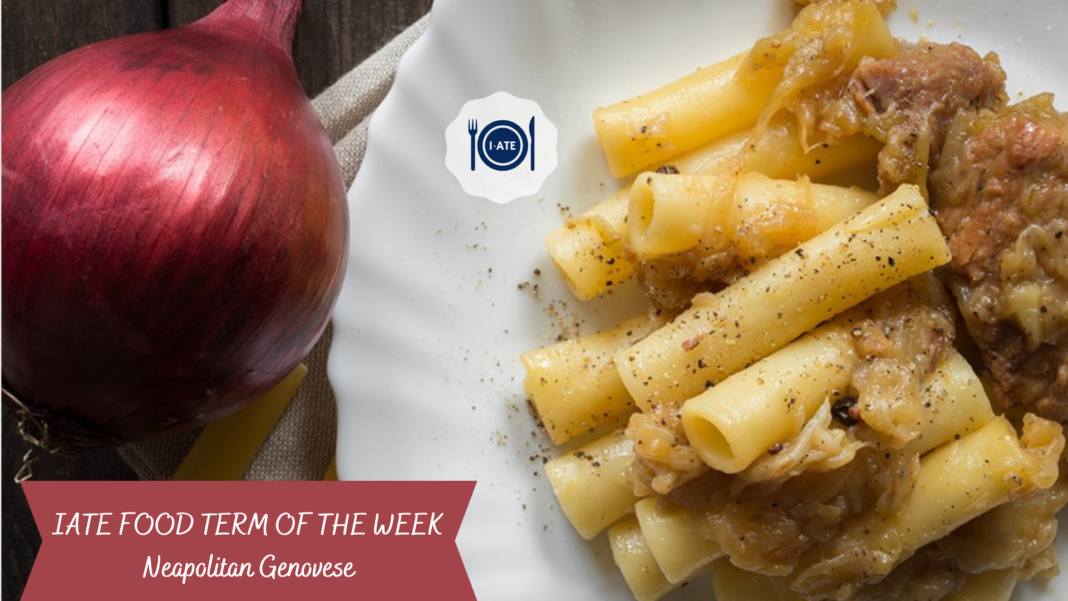Close your eyes. You have just been woken up by the delicious smell of meat and onions that have been slowly cooking for the last couple of hours. This is what a typical Sunday morning might be like if you live in Naples and your family loves having Genovese for lunch.
In spite of its name, which may recall the Italian city of Genoa (Genova in Italian) as well as the Swiss sauce génevoise, the Genovese is a typical Neapolitan sauce prepared with beef, onions, celery, carrots, with a slight flavour of wine, and whose story still remains a mystery. Apparently, various theories have been formulated to try and explain its origins; it may have been first prepared by a Neapolitan cook known as “o’ Genovese” (literally, “the Genoese”), or it may have derived from a recipe brought to Naples by Genoese sailors. Be that as it may, its first formal description dates back to 1790, when Francesco Leonardi described the so-called Maccaroni alla Napolitana (literally, “macaroni pasta cooked in the Neapolitan way”) and its variants with or without tomato sauce, nowadays known, respectively, as ragù and Genovese.

Probably connected to the bœuf à la mode, a similar French recipe, the Genovese can be eaten as a pasta seasoning as well as a main course because of the meat. As it often happens with traditional recipes, each family may have its own secrets to prepare it; however, there is a recipe which may be used as a reference.
Different cuts of meat may be used, also depending on their cost, but rump of beef is the preferred one; a traditional soffritto also plays a major role and it consists of carrots, celery, and of course onions (Coppery Montoro onions are the preferred variety); a glass of white wine completes the sauce. Some people also add a bay leaf, since it is considered perfect for particularly rich recipes, and it also adds flavour. The sauce should cook incredibly slowly for at least two to up to ten hours, so that the onions are well stewed and almost melt, and the meat becomes very tender. The traditional pasta shape to use is ziti, whose name recalls zita (‘bride’ in some local dialects), since they used to be served during wedding lunches. Ziti, which are long and tubular, should be broken in half by hand, so that their small fragments mix with the sauce, making it even richer.
Here is the full recipe for four servings.
Ingredients:
- Ziti, 320 g
- Beef, 600 g
- Onions, 1.5 kg
- Celery, 75 g
- Carrots, 75 g
- Parsley, 1 sprig
- Bay leaf, 1 leaf
- White wine, 1 glass
- Olive oil
- Salt
Firstly, prepare a soffritto with finely-cut onions, carrots, and celery. Prepare the meat: remove any excess fat that may be and tie the parsley and bay leaf to it; you should also cut the meat in more pieces. Put some oil in a pot, add soffritto, and let cook for some minutes on low heat. Then add meat, salt, and let cook (remember to put the pot lid on) for at least three hours. Then, add a glass of white wine and let it evaporate, before letting the sauce cook for an additional hour without the pot lid. Finally, cook the ziti in salted boiling water and serve with your delicious Genovese sauce, adding grated parmigiano (Parmesan cheese) if you wish!
References:
Bloc-Notes culinaire. 2016. Sauce Génevoise. [ONLINE] Available at: https://www.bloc-notes-culinaire.com/2016/10/sauce-genevoise.html [Accessed 5 May 2022].
èCampania. La storia del sugo alla genovese. [ONLINE] Available at: https://ecampania.it/event/storia-sugo-alla-genovese/ [Accessed 5 May 2022].
Gambero Rosso. 2019. Origine e storia della Pasta alla genovese. [ONLINE] Available at: https://www.gamberorosso.it/notizie/origine-e-storia-della-pasta-alla-genovese/ [Accessed 5 May 2022].
Giallo Zafferano. Genovese. [ONLINE] Available at: https://ricette.giallozafferano.it/Genovese.html [Accessed 5 May 2022].
Italian Home Cooking. La genovese (Neapolitan beef and onion braise). [ONLINE] Available at: https://italianhomecooking.co.uk/2017/03/29/la-genovese-neapolitan-beef-onion-braise/ [Accessed 18 May 2022].
Passeport pour la cuisine. 2019. Boeuf mode [ONLINE] Available at: https://passeportpourlacuisine.com/2019/03/26/boeuf-mode/ [Accessed 5 May 2022].
Written by Alessia Battista, PhD student in “European Languages and Specialised Terminology” at the University of Naples “Parthenope”.

